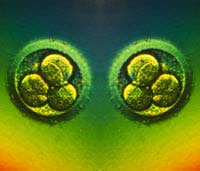

Rewiring the egg: mechanism remains murky.
From a scientific viewpoint, the cloning of human embryos may be more of a step than a leap, say sceptics. If the signals that turn adult cells into embryonic ones can be found, the creation of cloned embryos for tissue repair may become redundant.
Researchers at Advanced Cell Technology (ACT) in Worcester, Massachusetts, now report that they have created cloned human embryos. They aimed to make blastocysts, hollow balls of cells from which embryonic stem cells can be isolated and used to grow immunologically matched tissues to replace diseased ones.
Other researchers question whether ACT’s short-lived embryos, which did not become blastocysts, are a success. “A critical stage of development is the kicking in of genes,” explains Harry Griffin of the Roslin Institute in Edinburgh, which cloned Dolly the sheep. “They didn’t get over this threshold.”
The ACT team transferred nuclei from adult skin and ovarian cells into human eggs that had been stripped of their own chromosomes. Of 19 eggs, 11 appeared to undergo early stages of embryo development by forming a ’pronucleus’, a structure which forms in eggs fertilised with sperm. Two went on to divide into 4 cells and one into 6 cells1.
Embryonic genes in the nucleus only get switched on at, or after, this stage, explains embryologist Richard Gardner of the University of Oxford, UK. Before this, embryos are instructed by molecules in the mother’s egg cell. It is unclear whether ACT’s early embryos would progress any further, says Gardner.
Damage to genes incurred during manipulation of the nucleus can halt further development, explains John Gurdon, who studies embryos at the University of Cambridge, UK. The success rate for all cloning attempts so far “is very low indeed”, says Gurdon.
Many researchers are trying to uncover the underlying mechanism by which adult nuclei, which have stopped dividing, are ’reprogrammed’ – made to switch off adult genes and switch on embryonic ones. With most work being done in mice, sheep and cows, “There’s almost nothing known in humans”, says Gurdon.
If such signals can be identified, they might be used directly on adult human cells, points out Griffin, to turn them into the tissue of choice. “Maybe we can miss out the first stage and reprogramme directly,” he says.
This would alleviate the need for human eggs in the cloning procedure altogether. It would also avoid the risks of genetic defects in cloned tissues, which have been reported in some cloned animals.
ACT are already working on alternatives to human cloning. In the same paper they describe a technique in which they stimulated human eggs – before the stage at which they halve their number of chromosomes – to divide and form embryos without fertilization by sperm. Using a chemical that triggers ions to enter the cell, they activated 22 eggs, of which 6 went some way towards forming blastocysts.
References
- Cibelli, J.B. et al. Somatic cell nuclear transfer in humans: pronuclear and early embryonic development. The Journal of Regenerative Medicine, 2, 25 – 31, (2001).












